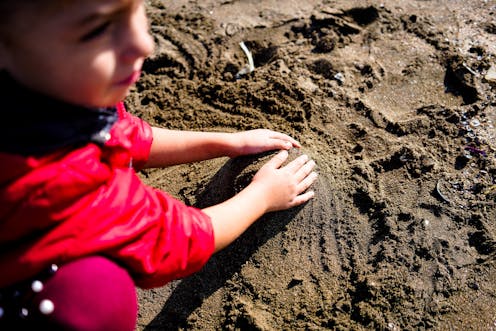4 tips from a sculptor
- Written by Sanné Mestrom, Senior Lecturer, DECRA Fellow, Sydney College of the Arts, University of Sydney

One of the things kids love most about the beach is the chance to play with sand. Sand is an excellent material to play with. It is versatile, widely available[1], open-ended and cheap.
Not only is it nature-based[2], but it involves manipulation, exploration, and construction with materials to create imaginary worlds.
On top of being endlessly fun, research also shows[3] clear associations between sand play and children’s physical, cognitive and social–emotional development. This includes[4] fine motor and gross motor skills, measurement, cooperative building, sharing and pretending.
Sand is also used in psychotherapy methods[5] for children. In sand play therapy, children are given a sand pit and helped to communicate their thoughts, experiences and emotions using sand, water, miniature figurines and their hands.
As a nonverbal approach, this therapy is especially effective when working with children experiencing trauma, distress and disabilities.
Here are four tips to make the most of it over summer for you and your kids.
1. Don’t overthink it
While my five-year-old son and I live in the Blue Mountains, we regularly jump on the train to Bronte or Bondi Beach. Once there, I’ll grab a coffee, and we hit the sand. All we will have with us are our togs, a small chamois each and a sarong, which doubles as a beach towel.
For us, it’s important not to be burdened with too much stuff. The beach already has everything we need: sand, water, shells, sticks, rocks, pebbles and other random discarded and found objects.
The coffee cup quickly becomes a small mould for sculpting and doubles as a vessel for carrying sea water. While you can certainly buy great sand accessories (sophisticated brick and castle moulds, for example), these actually limit the potential of open-ended free-play[6].
2. Start with simple ideas
When you’re given free reign to create whatever you like, the limitless options can be overwhelming. Where do you begin? Let’s start with the simplest things:
Sculpting
When it’s dry, sand can be mounded, poured, and measured. When it’s wet, the sand can be moulded, shaped, and carved. Repurpose your cup or use recycled plastic containers as sand scoops to form various upturned sculptural shapes. You can of course create a stacked castle with these, or an elaborate, ever-expanding sand mandala[7]. This is an abstract circular pattern of intricate designs that is ultimately washed away.
Structure
Experiment with scientific principles relating to gravity and force to problem solve your sculptures. For example, try reinforcing your sand tunnels with sticks and driftwood to give them structural integrity. The last time we were built tunnels at the beach, we emulated the layers of a large construction bridge we’d seen just days before. It was a great way to take something we’d seen in the built world, and apply it directly to our own sculptures.
Pattern
Walk to the end of the bay and collect as many interesting objects as you can find. This could be an array of dried and contorted seaweed, stripey pebbles, translucent sandblasted glass, bottle tops and textured and colourful seashells. The more the better. Try to find patterns in texture, scale, colour and form and use these to extend your sculpture project.
3. Try and find the flow state
As a lecturer in sculpture, I apply the same principles to my art students as I do to my young son: make sure give yourself plenty of open-ended, unstructured time. Sand play is first and foremost a creative pursuit, and as with any creative pursuit, you need to allow for as much time as possible to enter the “flow state[8]”.
This happens when we become so deeply focused on a task and pursue it so effortlessly that all else disappears, including the passage of time, worry of failure, self-reflection, self-critique, or sense of authorship.
4. Use the beach as a conversation starter
The beach is not just about the waves, the sand and ice-creams. It can provoke ideas and conversations, big and small. For example:
think about how far your shells and glass might have travelled to find their way to your feet. I recall collecting an ancient coconut fossil on a beach in northern New Zealand as a child. It was a small, shrunken black nugget – the size of a strawberry. I found the idea of this transformation mind-blowing and still have the little treasure with me to this day
collect rubbish at the beach and talk about single-use plastic[9] – how far plastic pollution can travel and how dangerous it is for ocean life
and my favourite: use your time at the beach to chat about the phenomena that give shape to our everyday lives, such as the interconnection of ocean tides[10], the moon and gravity, how waves travel[11] across the globe, and how the sun maps[12] the movement of time.
In this way, sand play is not just for children, it enriches us all.
Read more: This new ‘risky' playground is a work of art – and a place for kids to escape their mollycoddling parents[13]
References
- ^ versatile, widely available (journals.sagepub.com)
- ^ nature-based (www.tandfonline.com)
- ^ research also shows (eric.ed.gov)
- ^ includes (www.communityplaythings.com)
- ^ psychotherapy methods (www.sciencedirect.com)
- ^ free-play (eric.ed.gov)
- ^ sand mandala (unpluggedfamilytime.com)
- ^ flow state (link.springer.com)
- ^ single-use plastic (www.natgeokids.com)
- ^ interconnection of ocean tides (theconversation.com)
- ^ waves travel (www.abc.net.au)
- ^ sun maps (stemplayeveryday.com)
- ^ This new ‘risky' playground is a work of art – and a place for kids to escape their mollycoddling parents (theconversation.com)
Read more https://theconversation.com/how-to-get-the-most-out-of-sand-play-4-tips-from-a-sculptor-195209

















